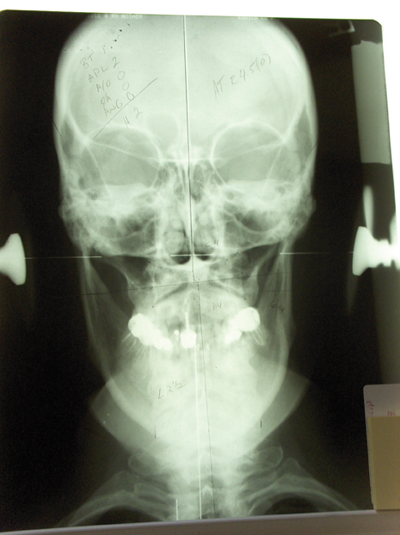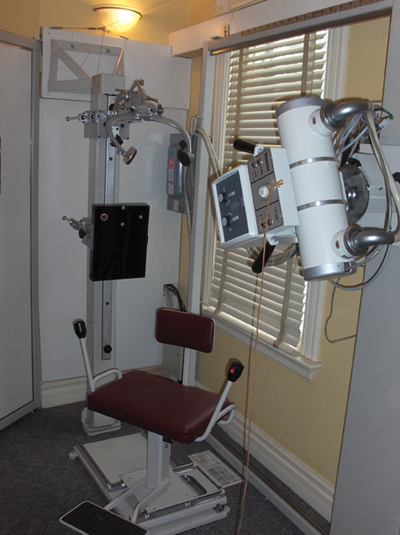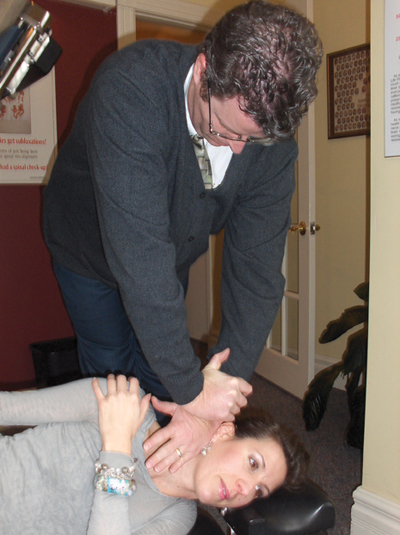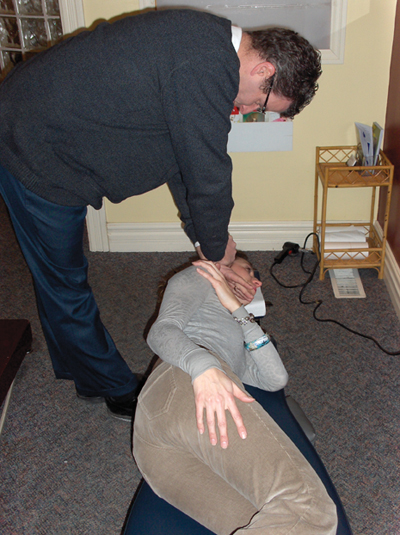
A 55-year-old investment banker presents to the chiropractic clinic after being referred by his medical doctor.
A special thank-you goes to Dr. Nathan Stine of Mississauga, Ontario, and Dr. Brett Moore and his office staff of Oakville, Ontario, for their assistance with this article.
Sample Case
A 55-year-old investment banker presents to the chiropractic clinic after being referred by his medical doctor. The patient reveals that he has high blood pressure, which his medical doctor is currently evaluating, and considering placing him on medication for. His medical doctor has read about a chiropractic technique that may decrease mild hypertension, and wants the patient to try it, before being placed on medication.
 |
|
| Photo 1: A sample of a Nasium X-ray is displayed, (Anterior to Posterior Skull) tube angled at the same degree as atlas inclination, to determine the atlas laterality.
|
Postural analysis demonstrates a left head tilt, low right shoulder and high right pelvis. Leg length analysis demonstrates a short right leg in the supine position. Physical examination reveals all cervical ranges of motion to be decreased. Motion and static palpation reveal the atlas to be subluxated, with concurrent hypertonicity of the sub-occipital muscles. The chiropractor is certified under the National Upper Cervical Chiropractic Association (NUCCA) to perform the NUCCA technique. Therefore, following the physical examination, the doctor takes a series of cervical X-rays, and uses a mathematical calculation, to determine the exact misalignment of the subluxated atlas. Once the calculation is established, an adjustment is given to the atlas in a vector determined to correct the subluxation. X-rays are retaken, to determine that the atlas is indeed corrected post-adjustment. Following the treatment, the patient states that he barely felt the adjustment and wonders if indeed anything happened to his spine. (The technique is very gentle, and because the correction vector is so precise, no additional force is required.) The doctor reassures the patient that the adjustment went just as planned, and his problem has been addressed. A few weeks later, the patient joyfully expresses to the chiropractor that his medical doctor found his blood pressure to have decreased significantly.
Can this really happen? Can a specific adjustment to the atlas cause a decrease in a person’s high blood pressure? In fact, research is pointing in exactly that direction. In this edition of Technique Toolbox, I will describe the NUCCA technique, its method of assessment and its corrective procedure.
History
NUCCA was officially developed in 1966 by Dr. Ralph Gregory. From the early 1940s, Dr. Gregory had collaborated with Dr. John Grostic to evolve a more biomechanically accurate system of upper cervical subluxation correction.1 During this time, incorporation of precisely aligned X-ray equipment and patient placement was introduced, minimizing any distortion.1 Inclusion of instrumentation – such as the cephalometer, a skull divider for establishing a central line – helped establish precise laterality of the atlas. Rapidly following this work were the concepts of atlas-odontoid relationship, axis-spinous position, the method for determining atlas rotation, the discontinuance of the recoil for the triceps pull adjustment, and the horizontal resultant. Analytical instruments and adjusting tables were also modified. These developments provided the biomechanical basis for NUCCA.1
Hypertension Research
Appearing in the Journal of Human Hypertension 2007,3 this pilot study had 50 early stage hypertensive patients randomly divided into two groups of 25. The control group received a sham adjustment, and the experimental group received a precise NUCCA adjustment. The results showed that compared to the sham-treated patients, those who got the real procedure saw an average of 14mm Hg greater drop in systolic blood pressure, and an average of 8mm Hg greater drop in diastolic blood pressure. According to Dr. George Bakris, the medical doctor leading the study, “when the statistician brought me the data, I actually didn’t believe it, it was way too good to be true.”4 Dr. Bakris further stated that “this procedure has the effect of not one, but two blood-pressure medications given in combination, and it seems to be adverse-event free.”4 This study will now spawn future studies into the exact physiological effects of the NUCCA adjustment on hypertension.
So, how is a NUCCA adjustment performed?
Let us assume that a full exam has been performed, and no contraindications exist.
 |
|
| Photo 2: Modified X-ray equipment is displayed, to help determine precise atlas misalignment.
|
Step 1: Analysis
Supine leg check – Doctor checks for leg length inequality (short leg).
Thermal Instrumentation – Bilateral thermal readings of each spinal nerve reveal the location(s) of inflammation.
Hip height check with hip calipers and/or anatometer – Calipers with an inclinometer indicate the low hip. The doctor can also check shoulder heights and head tilt with the calipers.
X-ray analysis – Three views are taken: lateral, vertex and nasium views. (See photos 1 and 2.)
Lateral cervical film – to establish a posterior to anterior incline of atlas.
Vertex film – (superior to inferior skull) tube angled 45 degrees to capture a superior to inferior view of atlas, to determine the amount of rotation.
Nasium film – (anterior to posterior skull) tube angled at the same degree as atlas inclination, to determine the atlas laterality.
 |
|
| Photo 3: Frontal View of a NUCCA adjustment. Doctor standing in a balanced levered position determined by the patient’s X-rays. Headpiece specifically positioned based on vector calculation. | |
 |
|
| Photo 4: Side View of NUCCA adjustment. The toggle recoil has been replaced with the “Triceps pull” in which the lateral aspect of the shoulder muscles contract (visualize scapular retraction).
|
Step 2: NUCCA Correction
(See photos 3 and 4.)
Patient: Side posture, atlas laterality side up.
Doctor: Standing in a balanced levered position determined by the patient’s X-rays.
Table: Headpiece positioned based on vector calculation.
Contact: Pisiform on lateral aspect of the TVP of atlas.
Stabilization Hand: Anatomical snuffbox of contact hand.
LOC: Correction vector determined by mathematical calculation of individual patient. It is important to note that the thrust is not a toggle recoil, but rather a “triceps pull” in which the lateral aspect of the shoulder muscles contract (visualize scapular retraction).
The doctor’s levered position and atlas contact creates potential energy. The triceps’ pull transforms the potential energy into kinetic energy, which allows the head and neck to release the misaligned atlas into a proper mechanical position.2
As a profession, we have always believed that chiropractic has a global effect on the nervous system, which in turn can assist with a multitude of health concerns in the body. NUCCA technique, and the research that is continuing to surround and support it is helping pave the way to proving that concept.
As usual, I have only scratched the surface of this technique. To truly learn NUCCA analysis and adjustments, enrol in a seminar at www.nucca.org. If you would like to see a specific technique featured in a future edition of Technique Toolbox, e-mail me at johnminardi@
hotmail.com.
Until next time… Adjust with Confidence.
For article with references, please visit www.cndoctor.ca.
Print this page